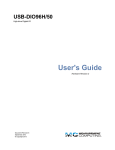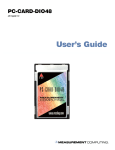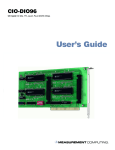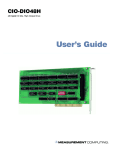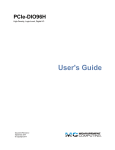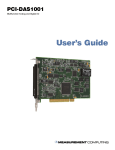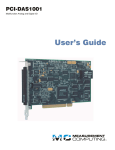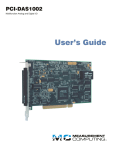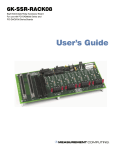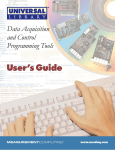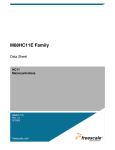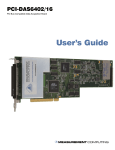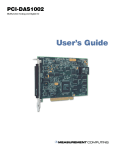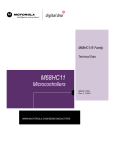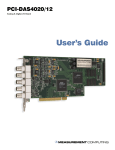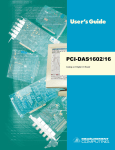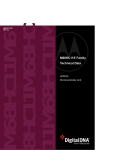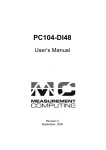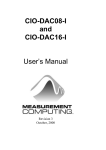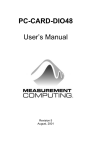Download USB-DIO96H/50 User`s Guide
Transcript
USB-DIO96H/50 High-drive Digital I/O User's Guide Hardware Revision 2 Document Revision 9 June 2015 © Copyright 2015 Your new Measurement Computing product comes with a fantastic extra — Management committed to your satisfaction! Thank you for choosing a Measurement Computing product—and congratulations! You own the finest, and you can now enjoy the protection of the most comprehensive warranties and unmatched phone tech support. It’s the embodiment of our mission: To provide data acquisition hardware and software that will save time and save money. Simple installations minimize the time between setting up your system and actually making measurements. We offer quick and simple access to outstanding live FREE technical support to help integrate MCC products into a DAQ system. Limited Lifetime Warranty: Most MCC products are covered by a limited lifetime warranty against defects in materials or workmanship for the life of the product, to the original purchaser, unless otherwise noted. Any products found to be defective in material or workmanship will be repaired, replaced with same or similar device, or refunded at MCC’s discretion. For specific information, please refer to the terms and conditions of sale. Harsh Environment Program: Any Measurement Computing product that is damaged due to misuse, or any reason, may be eligible for replacement with the same or similar device for 50% of the current list price. I/O boards face some harsh environments, some harsher than the boards are designed to withstand. Contact MCC to determine your product’s eligibility for this program. 30 Day Money-Back Guarantee: Any Measurement Computing Corporation product may be returned within 30 days of purchase for a full refund of the price paid for the product being returned. If you are not satisfied, or chose the wrong product by mistake, you do not have to keep it. These warranties are in lieu of all other warranties, expressed or implied, including any implied warranty of merchantability or fitness for a particular application. The remedies provided herein are the buyer’s sole and exclusive remedies. Neither Measurement Computing Corporation, nor its employees shall be liable for any direct or indirect, special, incidental or consequential damage arising from the use of its products, even if Measurement Computing Corporation has been notified in advance of the possibility of such damages. Trademark and Copyright Information Measurement Computing Corporation, InstaCal, Universal Library, and the Measurement Computing logo are either trademarks or registered trademarks of Measurement Computing Corporation. Refer to the Copyrights & Trademarks section on mccdaq.com/legal for more information about Measurement Computing trademarks. Other product and company names mentioned herein are trademarks or trade names of their respective companies. © 2015 Measurement Computing Corporation. All rights reserved. No part of this publication may be reproduced, stored in a retrieval system, or transmitted, in any form by any means, electronic, mechanical, by photocopying, recording, or otherwise without the prior written permission of Measurement Computing Corporation. Notice Measurement Computing Corporation does not authorize any Measurement Computing Corporation product for use in life support systems and/or devices without prior written consent from Measurement Computing Corporation. Life support devices/systems are devices or systems that, a) are intended for surgical implantation into the body, or b) support or sustain life and whose failure to perform can be reasonably expected to result in injury. Measurement Computing Corporation products are not designed with the components required, and are not subject to the testing required to ensure a level of reliability suitable for the treatment and diagnosis of people. HM USB-DIO96H_50_R2 2 Table of Contents Preface About this User's Guide ....................................................................................................................... 4 What you will learn from this user's guide ......................................................................................................... 4 Conventions in this user's guide ......................................................................................................................... 4 Where to find more information ......................................................................................................................... 4 Chapter 1 Introducing the USB-DIO96H/50 .......................................................................................................... 5 USB-DIO96H/50 block diagram ........................................................................................................................ 6 Chapter 2 Installing the USB-DIO96H/50 .............................................................................................................. 7 Unpacking........................................................................................................................................................... 7 Installing the software ........................................................................................................................................ 7 Installing the hardware ....................................................................................................................................... 7 Connecting the external power supply .............................................................................................................................. 7 Connecting the USB-DIO96H/50 to your system ............................................................................................................. 7 Signal connections .............................................................................................................................................. 8 P1 pinout ........................................................................................................................................................................... 8 P2 pinout ........................................................................................................................................................................... 9 Field wiring and signal conditioning................................................................................................................................. 9 Chapter 3 Functional Details ............................................................................................................................... 11 Internal components ......................................................................................................................................... 11 USB connector .................................................................................................................................................................11 External power connector ................................................................................................................................................11 Molex connector ..............................................................................................................................................................11 Power source jumper JP2 .................................................................................................................................................12 USB LED .........................................................................................................................................................................12 PWR LED ........................................................................................................................................................................12 50-pin header connectors .................................................................................................................................................13 Pull-up/pull-down DIP switches ......................................................................................................................................13 Mechanical drawings ........................................................................................................................................ 14 Chapter 4 Specifications ...................................................................................................................................... 15 Digital input/output........................................................................................................................................... 15 Power ................................................................................................................................................................ 16 Environmental .................................................................................................................................................. 16 USB specifications ........................................................................................................................................... 16 Data transfer rates ............................................................................................................................................. 16 Mechanical ....................................................................................................................................................... 17 Signal connectors .............................................................................................................................................. 17 P1 .....................................................................................................................................................................................17 P2 .....................................................................................................................................................................................18 Declaration of Conformity .................................................................................................................. 19 3 Preface About this User's Guide What you will learn from this user's guide This user's guide describes the Measurement Computing USB-DIO96H/50 data acquisition device and lists device specifications. This manual covers revision 2 hardware and later This manual covers revision 2 of the USB-DIO96H/50 hardware, which uses a 5 V power supply. Revision 1 of the USB-DIO96H/50 hardware has a 9 V power supply and daisy-chained hub. For information on revision 1 hardware, refer to www.mccdaq.com/pdfs/manuals/USB-DIO96H-50_R1.pdf. Conventions in this user's guide For more information Text presented in a box signifies additional information related to the subject matter. Caution! Shaded caution statements present information to help you avoid injuring yourself and others, damaging your hardware, or losing your data. bold text Bold text is used for the names of objects on a screen, such as buttons, text boxes, and check boxes. italic text Italic text is used for the names of manuals and help topic titles, and to emphasize a word or phrase. Where to find more information Additional information about the USB-DIO96H/50 is available on our website at www.mccdaq.com. You can also contact Measurement Computing Corporation by phone, fax, or email with specific questions. Knowledgebase: kb.mccdaq.com Tech support form: www.mccdaq.com/support/support_form.aspx Email: [email protected] Phone: 508-946-5100 and follow the instructions for reaching Tech Support 4 Chapter 1 Introducing the USB-DIO96H/50 The USB-DIO96H/50 is supported under popular Microsoft® Windows® operating systems. The USB-DIO96H/50 is fully compatible with both USB 1.1 and USB 2.0 ports. The USB-DIO96H/50 provides 96 digital I/O lines, high output current. The 96 digital I/O lines are accessed through two 50-pin connectors. Each digital port group is divided into two 8-bit ports and two 4-bit ports, and is a discrete emulation of 82C55 mode zero operation. You can configure each port independently for either input or output. The USB-DIO96H/50 outputs are high-drive TTL that can source 24 mA and sink 64 mA. Additional buffering is typically not required to drive external devices. Each digital port has associated DIP switches to drive the ports high during power up and reset. You can optionally set these switches for a pull-down configuration. All I/O bits are set to input mode on power up and reset. The USB-DIO96H/50 is shipped in a rugged metal enclosure that you can mount on a DIN rail or on a bench (refer to Figure 9 on page 14). The USB-DIO96H/50 is powered by an external +5 V regulated power supply that is shipped with the board. A jumper-selectable Molex® connector is also available inside the case if you need an alternate power supply (the cable for this connector is not included). This manual covers revision 2 hardware and later This manual covers revision 2 of the USB-DIO96H/50 hardware, which uses a 5 V power supply. Revision 1 of the USB-DIO96H/50 hardware has a 9 V power supply and daisy-chained hub. For information on revision 1 hardware, refer to www.mccdaq.com/PDFs/Manuals/USB-DIO96H-50_R1.pdf. 5 USB-DIO96H/50 User's Guide Introducing the USB-DIO96H/50 USB-DIO96H/50 block diagram USB-DIO96H/50 functions are illustrated in the block diagram shown here. Figure 1. USB-DIO96H/50 functional block diagram 6 Chapter 2 Installing the USB-DIO96H/50 Unpacking As with any electronic device, you should take care while handling to avoid damage from static electricity. Before removing the device from its packaging, ground yourself using a wrist strap or by simply touching the computer chassis or other grounded object to eliminate any stored static charge. Contact us immediately if any components are missing or damaged. Installing the software Refer to the MCC DAQ Quick Start for instructions on installing the software on the MCC DAQ CD. Refer to the device product page on the Measurement Computing website for information about the included and optional software supported by the USB-DIO96H/50. Install the software before you install your device The driver needed to run the USB-DIO96H/50 is installed with the software. Therefore, you need to install the software package you plan to use before you install the device. Installing the hardware Before you connect the USB-DIO96H/50 to your computer, connect the external power supply that is shipped with the device. Connecting the external power supply Power to the USB-DIO96H/50 is provided with the +5 V external power supply (PS-5V3AEPS). You must connect the external power supply before connecting the USB cable to the USB-DIO96H/50 and your computer. To connect the power supply to the USB-DIO96H/50, connect the external power cord to the power connector labeled POWER IN on the USB-DIO96H/50 enclosure (P5 on the board). Refer to Figure 3 on page 11 for the location of this connector. The PWR LED lights up when +5 V power is supplied to the USB-DIO96H/50. If the voltage supply is less than +4.1 V or more than +5.6 V, the PWR LED does not light. Connecting the USB-DIO96H/50 to your system To connect the USB-DIO96H/50 to your system, connect the USB cable to a USB port on your computer or to an external USB hub that is connected to your computer. When you connect the device for the first time, multiple Found New Hardware dialogs open when the operating system detects the device. When installation is complete, the USB LED blinks and remains on. This indicates that communication is established between the device and the computer. If the USB LED turns off If the USB LED turns on but then turns off, the computer has lost communication with the USB-DIO96H/50. To restore communication, disconnect the USB cable from the computer, and then reconnect it. This should restore communication, and the USB LED should turn back on. Caution! Do not disconnect any device from the USB bus while the computer is communicating with the USB-DIO96H/50, or you may lose data and/or your ability to communicate with the USB-DIO96H/50. 7 USB-DIO96H/50 User's Guide Installing the USB-DIO96H/50 If your system does not detect the USB-DIO96H/50 Perform the following procedure if a USB device not recognized message displays when you connect the USB-DIO96H/50: 1. Unplug the USB cable from the USB-DIO96H/50. 2. Unplug the external power cord from the POWER IN connector on the enclosure. 3. Plug the external power cord back into the POWER IN connector. 4. Plug the USB cable back into the USB-DIO96H/50. Your system should now properly detect the USB-DIO96H/50 hardware. Contact technical support if your system still does not detect the USB-DIO96H/50. Signal connections The table below lists the board connectors, applicable cables, and compatible accessory boards. Board connectors, cables, accessory equipment Connector (P1 and P2) Compatible cables Compatible accessory products 50-pin 0.1" IDC type box header C50FF-x, 50-pin ribbon cable. x = 3 or 6 feet (Figure 2) SCB-50 CIO-SERB24/FD CIO-MINI50 (2) CIO-ERB48 CIO-TERM100 CIO-SERB48 CIO-SPADE50 (2) SSR-RACK24 CIO-ERB24 SSR-RACK48 P1 pinout 50-pin connector pinout (P1) Signal name GND FIRSTPORTC Bit 0 FIRSTPORTC Bit 2 FIRSTPORTC Bit 4 FIRSTPORTC Bit 6 FIRSTPORTB Bit 0 FIRSTPORTB Bit 2 FIRSTPORTB Bit 4 FIRSTPORTB Bit 6 FIRSTPORTA Bit 0 FIRSTPORTA Bit 2 FIRSTPORTA Bit 4 FIRSTPORTA Bit 6 SECONDPORTC Bit 0 SECONDPORTC Bit 2 SECONDPORTC Bit 4 SECONDPORTC Bit 6 SECONDPORTB Bit 0 SECONDPORTB Bit 2 SECONDPORTB Bit 4 SECONDPORTB Bit 6 SECONDPORTA Bit 0 SECONDPORTA Bit 2 SECONDPORTA Bit 4 SECONDPORTA Bit 6 Pin 50 48 46 44 42 40 38 36 34 32 30 28 26 24 22 20 18 16 14 12 10 8 6 4 2 •• •• •• •• •• •• •• •• •• •• •• •• •• •• •• •• •• •• •• •• •• •• •• •• •• 8 Pin 49 47 45 43 41 39 37 35 33 31 29 27 25 23 21 19 17 15 13 11 9 7 5 3 1 Signal name +5V FIRSTPORTC Bit 1 FIRSTPORTC Bit 3 FIRSTPORTC Bit 5 FIRSTPORTC Bit 7 FIRSTPORTB Bit 1 FIRSTPORTB Bit 3 FIRSTPORTB Bit 5 FIRSTPORTB Bit 7 FIRSTPORTA Bit 1 FIRSTPORTA Bit 3 FIRSTPORTA Bit 5 FIRSTPORTA Bit 7 SECONDPORTC Bit 1 SECONDPORTC Bit 3 SECONDPORTC Bit 5 SECONDPORTC Bit 7 SECONDPORTB Bit 1 SECONDPORTB Bit 3 SECONDPORTB Bit 5 SECONDPORTB Bit 7 SECONDPORTA Bit 1 SECONDPORTA Bit 3 SECONDPORTA Bit 5 SECONDPORTA Bit 7 USB-DIO96H/50 User's Guide Installing the USB-DIO96H/50 P2 pinout 50-pin connector pin out (P2) Signal name Pin GND THIRDPORTC Bit 0 THIRDPORTC Bit 2 THIRDPORTC Bit 4 THIRDPORTC Bit 6 THIRDPORTB Bit 0 THIRDPORTB Bit 2 THIRDPORTB Bit 4 THIRDPORTB Bit 6 THIRDPORTA Bit 0 THIRDPORTA Bit 2 THIRDPORTA Bit 4 THIRDPORTA Bit 6 FOURTHPORTC Bit 0 FOURTHPORTC Bit 2 FOURTHPORTC Bit 4 FOURTHPORTC Bit 6 FOURTHPORTB Bit 0 FOURTHPORTB Bit 2 FOURTHPORTB Bit 4 FOURTHPORTB Bit 6 FOURTHPORTA Bit 0 FOURTHPORTA Bit 2 FOURTHPORTA Bit 4 FOURTHPORTA Bit 6 100 98 96 94 92 90 88 86 84 82 80 78 76 74 72 70 68 66 64 62 60 58 56 54 52 ••• •• •• •• •• •• •• •• •• •• •• •• •• •• •• •• •• •• •• •• •• •• •• •• •• Pin Signal name 99 97 95 93 91 89 87 85 83 81 79 77 75 73 71 69 67 65 63 61 59 57 55 53 51 +5V THIRDPORTC Bit 1 THIRDPORTC Bit 3 THIRDPORTC Bit 5 THIRDPORTC Bit 7 THIRDPORTB Bit 1 THIRDPORTB Bit 3 THIRDPORTB Bit 5 THIRDPORTB Bit 7 THIRDPORTA Bit 1 THIRDPORTA Bit 3 THIRDPORTA Bit 5 THIRDPORTA Bit 7 FOURTHPORTC Bit 1 FOURTHPORTC Bit 3 FOURTHPORTC Bit 5 FOURTHPORTC Bit 7 FOURTHPORTB Bit 1 FOURTHPORTB Bit 3 FOURTHPORTB Bit 5 FOURTHPORTB Bit 7 FOURTHPORTA Bit 1 FOURTHPORTA Bit 3 FOURTHPORTA Bit 5 FOURTHPORTA Bit 7 Figure 2. C50FF-x cable Field wiring and signal conditioning Details on the following compatible field wiring products are available on our web site at www.mccdaq.com/products/screw_terminal_bnc.aspx: CIO-MINI50 – 50-pin screw terminal board. CIO-TERM100 – 100-pin screw terminal board (two 50-pin IDC connectors). CIO-SPADE50 — 16" × 4" termination panel which mates with both 37-pin and 50-pin connectors. SCB-50 – 50-conductor, shielded signal connection box. 9 USB-DIO96H/50 User's Guide Installing the USB-DIO96H/50 Details on the following compatible signal conditioning products are available on our web site at www.mccdaq.com/products/signal_conditioning.aspx: CIO-ERB24 – 24 Form C relays, 6 amp relay accessory board for digital signal conditioning. CIO-SERB24/FD – 24 Form C relays, 10 amp, fault detecting relay accessory board with socketed and field-replaceable relays. CIO-ERB48 – 48 Form C relays, 6 amp, relay, 50-pin accessory board for digital signal conditioning. CIO-SERB48 – 24 Form C relays, 10 amp relay accessory board with socketed and field-replaceable relays. SSR-RACK24 – 24-channel solid-state relay mounting rack for digital signal conditioning. SSR-RACK48 – 48-channel solid-state relay mounting rack with quad-format devices. For additional information about digital interfacing Detailed information regarding digital interfacing is contained in Guide to DAQ Signal Connections. This document is available on our web site at www.measurementcomputing.com/signals/signals.pdf. 10 Chapter 3 Functional Details Internal components The USB-DIO96H/50 components are shown in Figure 3. 1 2 5 6 Ports 1 through 4 (two 50-pin connectors) USB LED 3 USB IN connector External power connector (POWER IN) Molex connector (P6) 7 PWR LED 4 Power source jumper (JP2) 8 Pull-up/down DIP switches Figure 3. USB-DIO96H/50 components USB connector Connect the supplied USB cable between the device and the USB port on the computer (or USB hub connected to the computer). This connector is labeled USB IN on the enclosure and J1 on the board. External power connector The external power connector is labeled POWER IN on the enclosure and P5 on the board. Connect the POWER IN connector to the supplied +5 V external power supply (PS-5V3AEPS). When running at full load, the device draws 2.6 A from the supply. Molex connector The internal Molex connector is labeled P6 on the board. Remove the device enclosure to access this connector. Internal power connector pinout Pin 1 Pin 2 Pin 3 Pin 4 5V GND GND NC (no connect) 11 USB-DIO96H/50 User's Guide Functional Details Pin 1 (5 V) of the Molex connector is directly to the left of the power source jumper (JP2). Figure 4. Molex connector (P6) pin assignments Power source jumper JP2 The power source jumper is labeled JP2 on the board. Use this jumper to configure the USB-DIO96H/50 to use either the external power connector (POWER IN) or the internal Molex connector. Figure 6 shows the jumper in each configuration mode. Figure 5. JP2 configuration modes USB LED The USB LED indicates the communication status of the USB-DIO96H/50. It uses up to 5 mA of current and cannot be disabled. The table below explains the function of the USB LED. USB LED illumination LED Illumination Indication Steady green Continuous blink The USB-DIO96H/50 is connected to a computer or external USB hub. Initial communication is established between the device and the computer, or data is being transferred. PWR LED The PWR LED illuminates when external power is supplied. The USB-DIO96H/50 incorporates an on-board voltage supervisory circuit that monitors the external power supply. The PWR LED does not light under the following circumstances: when the input power falls below +4.1 V when the input power goes above +5.6 V 12 USB-DIO96H/50 User's Guide Functional Details 50-pin header connectors The USB-DIO96H/50 has two 50-pin connectors labeled P1 and P2. Connector P1 provides the following connections: 48 DIO connections (FIRSTPORTA Bit 0 through SECONDPORTC Bit 7) one ground connection (GND) one power connection (+5V) Connector P2 provides the following connections: 48 DIO connections (THIRDPORTA Bit 0 through FOURTHPORTC Bit 7) one ground connection (GND) one power connection (+5V) Each digital port group is divided into two 8-bit ports and two 4-bit ports, and is a discrete emulation of 82C55 mode zero operation. You can configure each port independently for either input or output. Pull-up/pull-down DIP switches Use the on-board DIP switches labeled PORT 1 through PORT 4 to configure the pull-up/down configuration for each port. Each set of DIP switches includes four switches labeled 1 to 4. Switch 1 controls PORTA, switch 2 controls PORTB, switch 3 controls PORTCL, and switch 4 controls PORTCH. Figure 7 shows the DIP switches used to configure Port 1. Figure 6. Pull-up/down switch configuration All DIP switches are configured by default for pull-up (PU). To configure for pull-down slide the switch to the PD position. 13 USB-DIO96H/50 User's Guide Functional Details Mechanical drawings Figure 7. Circuit board dimensions Figure 8. Enclosure dimensions 14 Chapter 4 Specifications This specification applies to revision 2 hardware and later This specification covers revision 2 of the USB-DIO96H/50 hardware, which uses a 5 V power supply. Revision 1 of the USB-DIO96H/50 hardware was designed with a 9 V power supply and daisy chained hub. For revision 1 hardware specifications, refer to www.mccdaq.com/PDFs/Manuals/USB-DIO96H-50_R1.pdf. All specifications are subject to change without notice. Typical for 25 °C unless otherwise specified. Specifications in italic text are guaranteed by design. Digital input/output Table 1. Digital I/O specifications Parameter Specification Output Input Configuration Pull-up/pull-down Number of I/O Output high Output low Input high Input low Input impedance Source current Sink current Power up state Debounce mode 74ABT244A 74ACT373 Eight banks of 8, eight banks of 4, programmable by bank as input or output High impedance pull-up/pull-down selectable via DIP switch for each digital input port. 96 2.0 V min @ –24 mA 0.5 V max @ 64 mA 2.0 V min, 5.5 V max 0.8 V max, –0.5 V absolute min 47 kΩ (series resistance) 24 mA per output max 64 mA per output max Input mode Debouncing option available through firmware that samples all inputs eight times over a specified interval and latches out the input state only when eight consecutive samples are identical (all 0s or all 1s). Available debouncing intervals are 1 ms, 2 ms, 5 ms, 10 ms, 20 ms, 50 ms, 100 ms, 200 ms, and 400 ms. +0% / –12.5% Debounce interval accuracy 15 USB-DIO96H/50 User's Guide Specifications Power Table 2. Power specifications Parameter Conditions USB +5 V input voltage range USB +5 V supply current External power input (Note 1) All modes of operation External power supply (included) Alternate external power supply Voltage supervisor limits Power supply current User 5 V output voltage range User 5 V output current available Specification 4.75 V min to 5.25 V max <100 mA 5 VDC ± 5% (5 VDC power supply provided) 5 VDC, 15 W, 5% regulation MCC p/n PS-5V3AEPS From PC auxiliary power (cable not included) 4.13 V > Vext or Vext > 5.59 V 4.13 V < Vext < 5.59 V Available at +5 V pins Total from all +5 V pins Jumper selectable Molex® connector internal to case PWR LED = Off (power fault) PWR LED = On 2.7 A max 4.0 V min, 5.25 V max 50 mA max Note 1: Voltage specification applies at barrel plug power input. The power supply provided with the board meets this specification at the rated total power supply current. If a different power supply is used, small line resistances could cause significant voltage drop between the power supply and the barrel plug input. Environmental Table 3. Environmental specifications Parameter Specification Operating temperature range Storage temperature range Humidity 0 °C to 60 °C –40 °C to 85 °C 0% to 90% non-condensing USB specifications Table 4. USB specifications Parameter Specification USB "B" connector USB device type Device compatibility USB cable type Input USB 2.0 (full-speed) USB 1.1, USB 2.0 A-B cable, UL type AWM 2527 or equivalent. (min 24 AWG VBUS/GND, min 28 AWG D+/D–) 3 m (9.84 ft) max USB cable length Data transfer rates Table 5. Data transfer rate specifications Parameter Specification Digital I/O transfer rates (software paced) System-dependent, 33 to 250 port reads/writes or single bit reads/writes per second typ 16 USB-DIO96H/50 User's Guide Specifications Mechanical Table 6. Mechanical specifications Parameter Specification Card dimensions Enclosure dimensions 304.8 × 121.9 × 20.0 mm (12.0 × 4.8 × 0.8 in.) 342.9 × 125.7 × 58.9 mm (13.50 × 4.95 × 2.32 in.) Signal connectors Table 7. Ribbon connector specifications Parameter Specification Connectors Compatible cables Compatible accessory products P1-P2: 50-pin 0.1" IDC type box header C-50FF-x 50-pin ribbon cable SCB-50 CIO-MINI50 (2) CIO-TERM100 CIO-SPADE50 (2) CIO-ERB24 CIO-SERB24/FD CIO-ERB48 CIO-SERB48 SSR-RACK24 SSR-RACK48 P1 Table 8. P1 pinout Pin 50 48 46 44 42 40 38 36 34 32 30 28 26 24 22 20 18 16 14 12 10 8 6 4 2 Signal name GND FIRSTPORTC Bit 0 FIRSTPORTC Bit 2 FIRSTPORTC Bit 4 FIRSTPORTC Bit 6 FIRSTPORTB Bit 0 FIRSTPORTB Bit 2 FIRSTPORTB Bit 4 FIRSTPORTB Bit 6 FIRSTPORTA Bit 0 FIRSTPORTA Bit 2 FIRSTPORTA Bit 4 FIRSTPORTA Bit 6 SECONDPORTC Bit 0 SECONDPORTC Bit 2 SECONDPORTC Bit 4 SECONDPORTC Bit 6 SECONDPORTB Bit 0 SECONDPORTB Bit 2 SECONDPORTB Bit 4 SECONDPORTB Bit 6 SECONDPORTA Bit 0 SECONDPORTA Bit 2 SECONDPORTA Bit 4 SECONDPORTA Bit 6 Pin 49 47 45 43 41 39 37 35 33 31 29 27 25 23 21 19 17 15 13 11 9 7 5 3 1 17 Signal name +5V FIRSTPORTC Bit 1 FIRSTPORTC Bit 3 FIRSTPORTC Bit 5 FIRSTPORTC Bit 7 FIRSTPORTB Bit 1 FIRSTPORTB Bit 3 FIRSTPORTB Bit 5 FIRSTPORTB Bit 7 FIRSTPORTA Bit 1 FIRSTPORTA Bit 3 FIRSTPORTA Bit 5 FIRSTPORTA Bit 7 SECONDPORTC Bit 1 SECONDPORTC Bit 3 SECONDPORTC Bit 5 SECONDPORTC Bit 7 SECONDPORTB Bit 1 SECONDPORTB Bit 3 SECONDPORTB Bit 5 SECONDPORTB Bit 7 SECONDPORTA Bit 1 SECONDPORTA Bit 3 SECONDPORTA Bit 5 SECONDPORTA Bit 7 USB-DIO96H/50 User's Guide Specifications P2 Table 9. P2 pinout Pin 100 98 96 94 92 90 88 86 84 82 80 78 76 74 72 70 68 66 64 62 60 58 56 54 52 Signal name GND THIRDPORTC Bit 0 THIRDPORTC Bit 2 THIRDPORTC Bit 4 THIRDPORTC Bit 6 THIRDPORTB Bit 0 THIRDPORTB Bit 2 THIRDPORTB Bit 4 THIRDPORTB Bit 6 THIRDPORTA Bit 0 THIRDPORTA Bit 2 THIRDPORTA Bit 4 THIRDPORTA Bit 6 FOURTHPORTC Bit 0 FOURTHPORTC Bit 2 FOURTHPORTC Bit 4 FOURTHPORTC Bit 6 FOURTHPORTB Bit 0 FOURTHPORTB Bit 2 FOURTHPORTB Bit 4 FOURTHPORTB Bit 6 FOURTHPORTA Bit 0 FOURTHPORTA Bit 2 FOURTHPORTA Bit 4 FOURTHPORTA Bit 6 Pin 99 97 95 93 91 89 87 85 83 81 79 77 75 73 71 69 67 65 63 61 59 57 55 53 51 18 Signal name +5V THIRDPORTC Bit 1 THIRDPORTC Bit 3 THIRDPORTC Bit 5 THIRDPORTC Bit 7 THIRDPORTB Bit 1 THIRDPORTB Bit 3 THIRDPORTB Bit 5 THIRDPORTB Bit 7 THIRDPORTA Bit 1 THIRDPORTA Bit 3 THIRDPORTA Bit 5 THIRDPORTA Bit 7 FOURTHPORTC Bit 1 FOURTHPORTC Bit 3 FOURTHPORTC Bit 5 FOURTHPORTC Bit 7 FOURTHPORTB Bit 1 FOURTHPORTB Bit 3 FOURTHPORTB Bit 5 FOURTHPORTB Bit 7 FOURTHPORTA Bit 1 FOURTHPORTA Bit 3 FOURTHPORTA Bit 5 FOURTHPORTA Bit 7 Declaration of Conformity Manufacturer: Address: Category: Measurement Computing Corporation 10 Commerce Way Suite 1008 Norton, MA 02766 USA Electrical equipment for measurement, control and laboratory use. Measurement Computing Corporation declares under sole responsibility that the product USB-DIO96H/50 EU EMC Directive 89/336/EEC: Electromagnetic Compatibility, EN 61326 (1997) Amendment 1 (1998) Emissions: Group 1, Class A EN 55011 (1990)/CISPR 11: Radiated and Conducted emissions. Immunity: EN61326, Annex A IEC 61000-4-2 (1995): Electrostatic Discharge immunity, Criteria C. IEC 61000-4-3 (1995): Radiated Electromagnetic Field immunity Criteria A. IEC 61000-4-4 (1995): Electric Fast Transient Burst immunity Criteria B. IEC 61000-4-5 (1995): Surge immunity Criteria B. IEC 61000-4-6 (1996): Radio Frequency Common Mode immunity Criteria A. IEC 61000-4-8 (1994): Power Frequency Magnetic Field immunity Criteria A. IEC 61000-4-11 (1994): Voltage Dip and Interrupt immunity Criteria A. Declaration of Conformity based on tests conducted by Chomerics Test Services, Woburn, MA 01801, USA in June, 2007. Test records are outlined in Chomerics Test Report # EMI4813.07. We hereby declare that the equipment specified conforms to the above Directives and Standards. Carl Haapaoja, Director of Quality Assurance Measurement Computing Corporation 10 Commerce Way Suite 1008 Norton, Massachusetts 02766 (508) 946-5100 Fax: (508) 946-9500 E-mail: [email protected] www.mccdaq.com




















